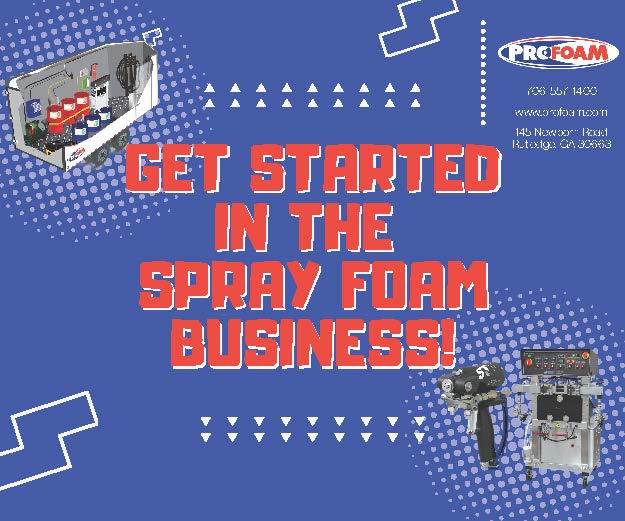
FAQ for Technical Spray Foam Topics
Question
Can spray foam be applied to the metal ceiling of a semi trailer roof? I need to make sure it will stay in place. I'm creating a cooler for live plants.
Answer
Spray foam is frequently used for cold storage rooms and other metal buildings. You need to follow the manufacturer's recommendations for installing foam to metal. Some metal surfaces need to be primed first. The surface must be clean and free of dust, dirt and oil. Generally, if the surface is paintable, it will be a good surface to receive foam.
Question
What are the proper thicknesses for open cell and closed cell spray foam applied in an attic?
Answer
What are the proper thicknesses for open cell and closed cell spray foam applied in an attic? How does this compare to building code prescribed R-values?
The proper thickness for spray foam applications in an attic vary depending on the difference in temperature between the interior and the exterior. There comes a point of maximum efficiency when added foam doesn’t provide cost effective insulation.
For example, in South Texas where temperatures average 95 degrees, and with a cold storage temperature of -10 degrees, the cost effective thickness of closed cell SPF is approximately five to six inches.
However, the thickness of maximum efficiency may not match the building code prescribed R-values. This is because most building codes are based on fiberglass insulation, not spray foam, which is often more efficient. In fact, SPFA has conducted comparison tests in attics and walls that show a 20 to 35 % greater energy efficiency than fiberglass insulated walls and attics in similar climate conditions.
Five inches of open cell foam to the underside of the attic will provide an R-value of approximately 19 - 20. Two inches of closed cell foam will provide an R-value of approximately 12 - 13.
Although these thicknesses may be adequate in certain situations, your code official may insist on full R-value thickness of 38 unless you provide them with research data that demonstrates the fact that lesser R-values of spray foam provide the equivalent insulation value of other insulation with higher R-values.
Question
We're working on a project with a limited budget (who isn't?) and the contractor is suggestiong that as a cost saving measure, we use a thin layer of closed cell spray foam insulation along the underside of the roof plywood followed by a thicker layer of open cell. The thought being this will provide the air and vapor seal we need, yet the open cell exposed to the interior will be less expensive. Is this logic flawed or can this be done without casuing potential condensation problems? The project is in the Portland, OR area.
Answer
Good question and thanks for telling us where your project is located. According to the 2012 International Residential Code (2009 version too) section R806.5, you must install at least an R-10 of air impermeable insulation such as open or closed-cell spray polyurethane foam under your roof deck in climate zone 4C (Portland) to help control condensation. If you prefer to use a combination of closed-cell and open-cell, I would suggest you install at least an R-10 of closed-cell before adding the open-cell. That's about 1.5 inches of closed-cell depending on who's closed-cell product you choose. That section of the code also has recommendations for all US climate zones when you want to combine different types of insulation under your roof deck.
Question
I frequently receive ceramic samples protected by expanding foams such as your Quick Shield product. Is there any method for recycle of this material?
Answer
I believe the Quick-Shield you are referring to is a low-density open-cell spray polyurethane foam. There has been research in the area of recycling spray polyurethane foam, but I do not believe the development of that has reached the consumer level. I believe this is being done in small quantities, but there is no company I can point you to that would recycle SPF material.
Question
Does spray foam gives off any VOC gases?
Answer
Spray foam is not considered to be a VOC emitter as are a lot of adhesives and solvent based paints. During application some VOCs may be released but after curing the it is very difficult to measure any chemical emissions from the foam. Many suppliers have performed testing on their foams. All of the foams in Canada are required to have testing for VOCs. Check with the foam supplier for additional data.
Question
Have you heard of anyone spray foaming the outside of an above ground pool. is there a certain type of spray that is better in this type application? Can the foam be exposed to elements or would an "outer skin" need to be applied and then the foam "sealed" inside the outer skin?
Answer
Technically, this could be done, but I would recommend it to be protected from UV light and physical damage. It is common to use spray polyurethane foam on the exterior of hot tubs that are placed either indoors or outdoors and protected. You could cover it completely with something like decorative wood paneling or a spray on coating that will do both such as a polyurea top coat.
Question
Im getting ready to sell one of our machines for a new unit. was wondering what is the best way to flush it out? and what product to use to do it?
Answer
We would recommend that you pump out the isocyanate lines with fresh isocyanate at least once a month. You need approximately 1.5 gallons for the machine and 0.5 gallons for each 50 feet of hose. Dispose of the old isocyanate as instructed by the supplied safety data sheet (SDS formerly MSDS).
Question
I have 1/2lb foam in the attic on the under side of the roof. my attic has gotten up to 90 degree in the heat of the summer. i was wanting to know if i can spray fiberglass blown in insulation on the sheetrock in the attic or should it not be done due to having the foam?
Answer
You should only have one thermal boundary in your building. If the underside of the roof deck is insulated and you have sealed off all vents in the attic, you should not have insulation on the attic floor. If you want to add more insulation, I would suggest adding more to the underside of the roof deck. There could be other things going on, but I would need more information.
Question
How do I get foam off of my hands?
Answer
If the foam has not cured or hardened, use acetone or similar solvent. Take caution not to use anything that will harm your skin or enter the bloodstream. If the foam has hardened, there is no solvent that will remove it. It will not harm your skin and will wear off in several days. To remove cured foam from skin, use a pumice stone (available at most drug stores) and warm, soapy water. Then apply petroleum jelly to soften your skin.
Here is another trick we use for some other chemicals that get stuck to hands. It is pretty safe, so perhaps it is worth a try if nothing else works...
Take an ordinary set of rubber/vinyl kitchen gloves. Fill them part way with water and dish soap. Clean your hands thoroughly first, keep them wet and insert them into the gloves. Tape the gloves around his wrists (tight enough so as they do not leak, but loose enough so as not to cut off circulation).
Keep them on for a few hours. Watch some TV, read the paper, whatever. After an hour or so, take them off and wash your hands up again.
The effect is similar to swimming in the pool all day and having prune-like hands. Often this softens the skin enough to help out. No guarantees, but maybe worth a try??
Question
What will stick to spay foam the will be environmentally friendly? Something I could spray or spackle on to just cover the walls. I do not want to leave the walls bare. The insulation comes passed the rafters so hanging anything like sheet rock or paneling will not work. Any help?
Answer
Per building code, all foam plastic, such as spray polyurethane foam, must separated from the interior of a building by an approved thermal barrier such as 1/2" gypsum wallboard. From your question, it seems like the area where the spray foam is installed is an occupied space. If it is an attic, then there is an exception where an ignition barrier can be installed instead. It's not a matter of what can stick, but what is required to be used over the foam per code. You should contact the foam applicator that installed the foam or the manufacturer of the foam for advice.
Question
I was hoping to save a bit of cash as were running out fast with our renovation. I was wondering if we could use a combination of fiberglass and spray foam. I was hoping to put R-12 fiberglass and then cover it with closed cell spray foam to finish off filling the 2X6 walls. I live in Northern Ontario and by code need a R-22. If this is not possible, can I get the walls spray foamed first with closed cell and then put the fiberglass? If I was to do this, would I need a vapor barrier? I love the idea of spray foam to stop air movement, but would really like to get the benefit of a moisture barrier as well. What about the ceilings? Is there anyway to be able to take advantage of the benefits in the attic on the cheap. Thanks a lot.
Answer
We call the combination of spay foam and air-permeable insulation, hybrid. Hybrid installations are possible by one of two methods:
1. Install a 0.5-1” flash spray of foam then fill the remaining cavity with your air-impermeable insulation. You will definitely need a vapor retarder on the interior side of this assembly. This is not the best option, because if the vapor retarder fails, there is a good chance that condensation could occur on the cold spray foam layer.
2. Install enough spray foam so that by adding the layer of air-permeable insulation, you will not have condensation at that juncture. In your area you’d need around an R-10 of closed-cell spray foam with an R-12 batt of air-impermeable foam.
For the roof deck, you may need around an R-30 of the closed-cell SPF and an R-19 amount of air-permeable insulation to finish the cavity.
It is possible, but you need to be careful. Also, these recommendations are assuming you are in a climate zone 7 per ICC-IECC building codes. Please consult with your contractor and/or the foam manufacturer that you choose to ensure you will not have any condensation issues.
Question
I would like to start Spray Foam Insulation business in Toronto. I need your help and guidance that what are the basic requirements of the business and how can I start.
Answer
The best bet is to contact a spray foam manufacturer or supplier and speak with them. There are many you can find on this website in fact. Most can provide the training and equipment necessary to become a SPF contractor. Many manufacturers service Canada or are based in Canada.
Question
I volunteer with a rescue group doing amazing work. Some neighbors have started complaining about the noise. The group has updated a small barn with kennel runs and I am asking if spray foam insulation can significantly reduce the barking noise heard from outside? Thank you.
Answer
Spray polyurethane foam (SPF) when applied properly based on the design of the building can be excellent in reducing noise transmission. SPF is very efficient at sealing up the structure retarding the direct paths for sound to travel. You should contact a SPF manufacture or a SPF contractor in your area to get some advice specific to your building.
Question
We have a job that has already been sprayed and they're having a slight odor problem. The foam was sprayed slightly off ratio but it still made good foam. Is there any type of coating we can put on the foam to block the odor or does the foam have to be removed?
Answer
Removal of the off-ratio foam is the correct recommendation.
Question
Can I use the foam to insulate underground water pipes? I have an outside boiler and I am losing about 50 degrees from boiler to furnace. Will the ground or moisture have any effect on the foam?
Answer
Foam can be used underground around water pipes as an insulation material. You will have to work with a spray polyurethane foam manufacturer to determine which foam formulation is best suited for the temperature range you are working with. Also, make sure to prepare the pipe trench so there will be proper drainage by creating a slope and using gravel to keep pools of water away from the foam.
Question
How do I remove dried A foam and B foam? We had two separate tanks leak and the material dried on a door frame and metal saddle.
Answer
The Resin/B side liquid chemical will leave a sticky layer. Without something to react it, it will stay tacky. It should be cleanable with soap and water.
Dried isocyanate/A side will adhere tenaciously and cannot be dissolved with anything that a homeowner should be handling. That material should be removed by mechanical means (grinder, sander), then the surface should be primed and repainted. If it is a stained wood, it will have to be sanded, sealed and refinished. The degree of sanding will depend on how far the material soaked into the wood. Some pieces might have to be replaced.
Question
When foaming the underside of a roof should the blown in fiberglass insulation be removed from the floor of the attic?
Answer
Yes! Some will argue, but the consensus from the building science experts and code say that if you create an unvented attic where you enclose an attic with spray polyurethane foam and seal off the vents you should remove any insulation or vapor retarders from the floor of the attic. You want the temperature and humidity from the interior to balance with the environment in the attic to keep condensation from forming. When doing this, you must also install the proper amount of insulation at the roof deck to meet code. The 2009 IECC and Section 806.4 of the 2009 IRC are great guides in determining how much insulation is required in an attic for this application
Question
We're located in a commercial real estate unit that has noise issues relating to people walking in the unit above. It appears that they have hardwood flooring above us in certain places. Will Spray Foam be able to reduce the noise level from above? Since we have a flat ceiling, how can spray foam be applied in this environment?
Answer
Spray Polyurethane foam can aid in reducing sound transmission in walls and ceiling cavities. In your case, however, since you cannot remove the ceiling gypsum to access the cavity, SPF may not be your answer. Any attempt is going to be pretty tricky, not tested, and the results may not be consistent without being able to see what’s going on in that cavity and control how it is filled. Filling the void completely could cause enough pressure to damage the existing ceiling. There may be other products out there, but I don’t think SPF is the way to go in this situation without being able to remove the ceiling. Best of luck. Please consult one of the SPF manufacturers for more information on sound transmission testing
Question
I have a homeowner who would like to have an SPF roof installed but they would like to know how hard it is to tear off before they put it on their home.
Answer
Spray polyurethane foam roofs can easily last the lifetime if they are properly maintained. The critical factor is to inspect the roof frequently and make sure the exterior UV protectant coating remains in place. If there are signs of coating degradation, new coating can easily be applied in these areas by a SPF roofing professional. After 10 years or so, an entire recoat may be necessary, but the foam remains untouched. If for whatever reason the homeowner would like the foam removed, it can be done by a SPF professional. There are sheet products that can be installed between the foam and wood deck that make removal easier if this is a concern.
Question
Will a oily film on a steel building affect how the insulation sticks?
Answer
Absolutely. The surface needs to be cleaned of dust and oil before being sprayed. A primer coating is sometimes recommended for new metal surfaces. For other surfaces, a good rule of thumb is, if you can paint it, you can spray foam to it. But, please, consult with your manufacturer for recommendations.
Question
when spraying form onto the rafters in my attic should I have ridge vents or do I need any opening in my attic at all to the out side?
Answer
You have several options when insulating your attic. You can place the insulation on the attic floor only which is your typical vented attic design. Another option is to place all the insulation on the underside of your roof deck and gable walls. In this case you would not have insulation on your attic floor and you would close up all your attic vents. You would not want to have any vents to the outside or that would be similar to keeping your windows open all the time. Your attic space would now be part of your conditioned space. Those are your most common methods but not all of them.
Question
I have a 30 year old single story home with approximately 4,000 sq. ft of living space. It has a very high roof and large attic space. If I cannot afford to spray the underside of the entire roof at once, is there any benefit to applying the spray to part of the underside of the attic and leaving the remaining part with fiberglass batts on the joists and vented through the soffits.
Answer
This is a very special case. If you want to spray only a portion of the underside of your roof deck, I'd recommend keeping the attic space vented completely. Do not seal up any of the soffit, gable, or ridge vents until you have insulated the entire roof deck. During this interim period, you should see some benefit. The foam can block some of the solar radiation coming through the roof deck. I would recommend insulating the areas that get the most sunlight first, such as the southern exposed sides.
However, you may find it less expensive in the long run to do it all at once. Getting the equipment there and the machines running can be a significant part of the cost.
Question
In our local building jurisdiction, a 15 minute thermal barrier is required to separate the spray foam insulation from the accessible attic space. When using DC 315 or an equivalent thermal paint barrier, will the homeowner ever need to reapply this product or a new thermal barrier? Does the painted thermal barrier have a lifetime?
Answer
The intumescent paints being used as ignition barriers and/or thermal barriers do not have an end of life use. They should last for the life of the building if not physically damaged. They do not age or lose their properties.
Question
What’s a "thermal barrier" and when is it needed?
Answer
A thermal barrier is a covering on the surface of the spray polyurethane insulation which will protect it for at least 15 minutes in the event of a fire. ½-inch gypsum wall board, such as Sheetrock®, is an approved 15 minute thermal barrier.
Building codes require the installation of a thermal barrier between foam plastics (such as spray polyurethane insulation) and any occupied space. Exceptions apply in some cases; review local codes and/or confer with your local building code officials.
The building code provides for an exception to the thermal barrier requirement in attics and crawl spaces where entry is made only for the service of utilities. In such cases, the spray polyurethane insulation must be protected from ignition. Several manufacturers offer a spray-on or hand applied ignition barrier coating for these areas.
Question
Which is better, closed or open cell?
Answer
Both systems offer significant advantages over fiberglass batting: ability to air seal; ability to fill cracks and conform to odd shaped cavities; and ability to hold their shape over time and under adverse conditions.
But only closed-cell foam has the thermal insulation value (R-value) to bring your home up to Energy Star® standards with only one-half the thickness required for fiber insulations. In addition, closed-cell foam products increases the strength of you wall system (it's approximately doubled) and increase the water resistance of your home's exterior. Open cell insulation is less expensive and provides supplier sound deadening characteristics.
Question
I have an inquiry from oversees friends that are in construction businesses and want to expand in SPF. What is the typical yield (in cu. ft.) of a set of 55-gallon closed-cell drums? Some sources say its 14 cu. ft., some say it’s 500. I understand yields may vary due to temp/and other factors, but generic reference number is all I need. Would be great to know for future reference what technical property of the product on the data sheet should one look for on the data sheet for yield and how to convert it to cu. ft. It seems like sale of a 55-gallon drum is somewhat inaccessible for general public. I noticed Dow and BASF have extensive product infos (or ads) but no info on locations where one can purchase their products. Any good locations in NY/NJ/CT area? Any hints on international shipments? I need to know if its handled as HazMat.
Answer
For more precise information on yield, technical information and purchasing information, you should contact one of the spray foam suppliers listed on this website. Many of these companies should be able to help you.






